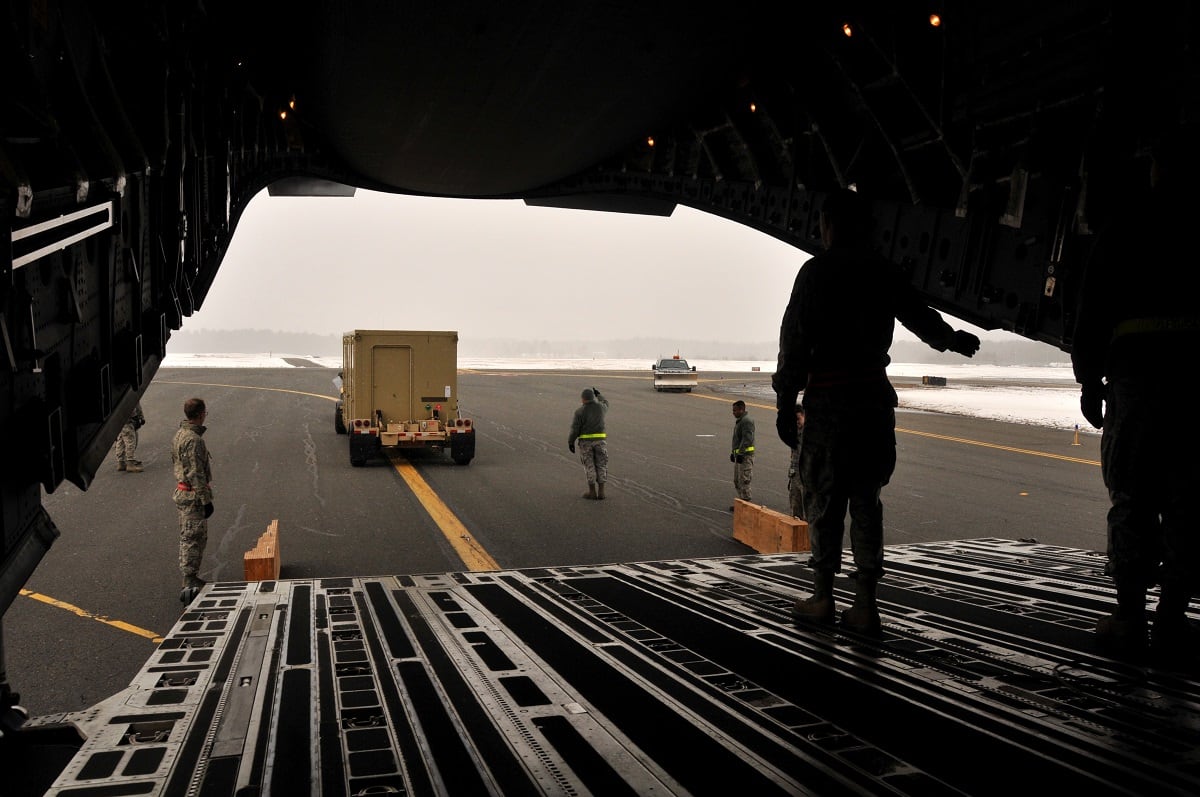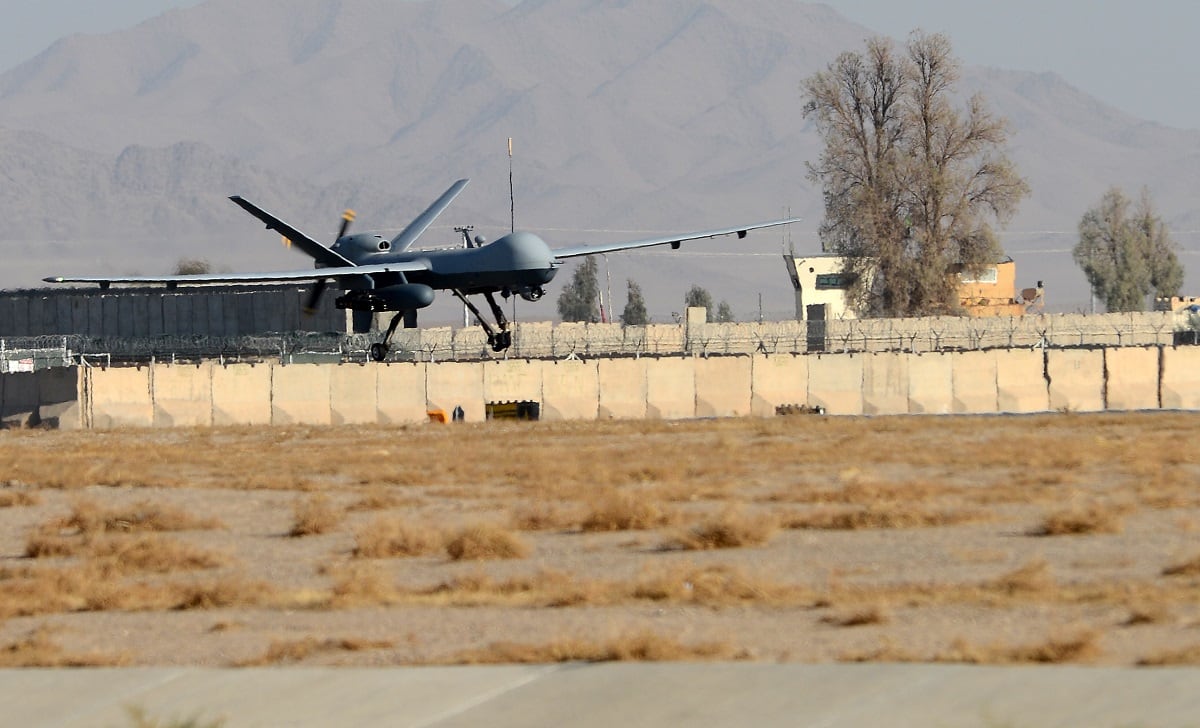Image 1 of 10
KRZESINY, Poland — If the U.S. Air Force finds itself in a conflict with Russia, it won’t be able to simply rely on its major operating hubs in Germany, Italy and the United Kingdom. So it’s getting more expeditionary thanks to a new “air base in a box” that will enable the service to rapidly move to a partner nation’s airfield, set up a squadron and begin flying combat missions.
Defense News traveled to Poland’s 31st Air Base near Krzesiny this July for an exclusive look at the first-ever trial of the U.S. Air Force’s new deployable air base system, or DABS — a series of humble-looking shipping containers filled with everything needed to stand up air operations, including temporary billeting and mess facilities, vehicles, airfield repair resources, and power and electrical equipment.
"When we deploy forward, we have very generous hosts, but in a crisis, they’re going to need their capabilities for their priorities, their mission sets, and we’re going to fight jointly and operate jointly,” said Brig. Gen. Roy Agustin, U.S. Air Forces Europe’s director of logistics, engineering and force protection.
“But rather than add a burden by adding our [requirements] — ‘Hey, can you provide us power, can you provide us lodging?’ — if we can bring that organic capability with us, we are both more capable and there’s more synergy as a result,” he told Defense News in a July 31 interview.
RELATED

While this capability comes at a fraction of the cost of a new, permanent air base, it still entails spending hundreds of millions of dollars on DABS and storage facilities based around Europe.
In fiscal 2019, the Air Force plans on spending $361 million for DABS equipment. The budget also includes funding for storage facilities to house DABS, including $119 million for Ramstein Air Base, Germany, and $87 million for one at Royal Air Force Fairford in the United Kingdom. A further $48 million will pay for production and deployment of “enhancements” to existing DABS infrastructure at undisclosed locations.
Gen. Tod Wolters, commander of U.S. Air Forces Europe, said funding these deployable air base packages is critical for improving the posture of the service on the European continent.
“Those funds have enhanced our lethality, our responsiveness and our resiliency, and we want to ensure that our soldiers, sailors, airmen and Marines are in a position where they can be quicker and faster and sharper and stronger than their predecessors,” he said.
RELATED

Because the Air Force didn’t start buying DABS until the FY18 budget and still doesn’t have a complete system, a full-up DABS was not used for this first deployment. Instead, airmen hustled to deploy a more cost-effective prototype version that was about 20 percent the size of a normal DABS, said Capt. Alex John, who helped plan the exercise.
"The scale doesn’t need to be huge yet because right now what we’re doing is we’re scripting the process for how we would actually forward deploy DABS,” he said. “What we’re able to do at a small scale, we’re able to do essentially the same exact way on a large scale. So it’s the same process, just more people and more equipment.”
The exercise starts ...
While planning for the exercise began almost a year ago, the proof of concept officially started in July, with the first members of the team arriving at Krzesiny on July 14, and the first trucks loaded on July 16 and then traveling from Sanem, Luxembourg, to Poland that day.
About 60 airmen from 13 different active, reserve and Air National Guard squadrons participated in the exercise. But of that, only a handful of airmen in leadership positions were given full insight into what to prepare for on the ground.
“We wanted to see how they would do it. Clean slate, tabula rasa, how these engineers would set up the tents,” John said. “Maybe they’d do it better than we planned, or different.”
In total, 87 trucks, two C-130J military transport aircraft and a train moved the equivalent of 321 pallets of equipment — including about 60 vehicles and 161 containers — into Poland by July 31. That same day, airmen began sending materiel back to Luxemburg, with 25 trucks departing Krzesiny once everything had been received.
The first equipment to arrive were things like forklifts and other vehicles needed for moving equipment. Following close behind were the materials needed to stand up the tent city — temporary housing, a main dining hall, shower facilities and a kitchen (port-a-potties were contracted by the service, but a real DABS would include latrines). Later on, two C-130 Hercules brought laundry facilities and air conditioning units.
Tech. Sgt. Dennis Ferguson, an engineering assistant, was one of the first airmen to arrive at Krzesiny on July 14.
“When we showed up, this whole field was thigh- to waist-high grass. The Polish knocked everything down for us. We leveled a little bit of stuff out, and then they filled in some holes for us that were out here,” he said.
“When you look at a map, you can only see so much from an aerial picture. It might look like the greatest place in the world to put tents, and then you get there and it’s low lying and it holds water or its full of holes and not exactly ideal.”
From there, the engineers figured out how to lay out the camp and began constructing the facilities. While there were no major problems, the process didn’t always go smoothly, Ferguson said. The main dining facility was a new piece of equipment that no one had experience setting up, and the written directions were packed in a separate box — turning its assembly into everyone’s worst Ikea furniture nightmare.
Then, engineers realized they had put the tent city downwind from the port-a-potties and had to reorganize the camp to keep living quarters habitable. Air conditioning units broke and had to be repaired, generators needed to be refueled and fuel consumption had to be monitored.
“There’s always something to improve on,” Ferguson said. “As soon as everything is set up, there’s always something that’s going to go wrong. If it’s mechanical, it’s going to break.”
RELATED

A little help from the Army
Another learning experience for the Air Force was using a train to transport goods; the service normally doesn’t rely on railroads and wanted to “stress test” that capability.
“We’re looking at all of our different options because in a contingency environment, if we don’t have enough trucks or we don’t have enough planes, we can use trains,” John explained.
For this exercise, the Air Force contracted with a commercial freight company, filling 19 rail cars with 31 shipping containers and 13 vehicles. It also leaned on the expertise of U.S. Army personnel temporarily deployed to Poland to provide logistical support for Operation Atlantic Resolve, the name for the U.S. mission meant to strengthen ties between NATO allies and other partners in Europe.
When the train showed up, it wasn’t configured in a way that made it easy to offload, said Staff Sgt. Zane Trapp, a movement supervisor for the Army’s 612th Movement Control Team, which helped the Air Force with customs paperwork, getting diplomatic clearances and transportation logistics.
“They probably didn’t know what it would look like at the download site, but we did,” he said. “We sent the train back out [from the loading dock] and reconfigured it. It took about an hour. And then the download took about two and a half hours, versus about five or six if it wasn’t reconfigured.”
While Trapp was explaining the reconfiguring process, Tech Sgt. Michael Creech, who led the Air Force’s transportation efforts during the exercises, dropped by to greet Trapp and thank him for helping out with the paperwork needed to get 25 trucks worth of equipment shipped out that day.
“This is one heck of a ride today,” Creech said, taking a short break for a minute in the air-conditioned dining tent — a welcome respite from the hot, muggy summer day. “We’ve got 11 [vehicles] done.”
“I have the rest of the forms too,” Trapp said.
“I’m glad you did. That was like a weight off the shoulders, too, because [I’m] running back and forth out there,” Creech replied.
After Creech left to finish up a long day’s work, Trapp commended the effort that he and other airmen were putting into the exercise.
“Twenty-five trucks is a lot when you're working in an expeditionary type of environment. I have a forklift. I have a crane. I don't really have established throughput and stuff that can stack things up for me quickly,” he said. "Most of the vehicles we have require a dock, so a lot of the times we can only do two trucks at a time, if that."
The proof of concept was designed to stress how much the Air Force could bring into a new base and how quickly it could be done. Much of the equipment moved into the area — large shipping containers filled with thousands of tons of concrete slabs to enable maintenance work, heavy high-voltage power generators that would be necessary to power a larger deployment — went unused.
“We have roughly an average of receiving 10 to 15 trucks a day. How much more than that are we able to handle is what we’re trying to figure out. Then we’ll come up with the maximum amount of the vehicles, trains, planes that we could receive in one day,” John said. “What is the fastest time frame to move all of this equipment?”
That may seem like a really simple exercise on paper, but logistics can break down on the smallest details, he said. Not being able to support flying operations for even a single day can have major consequences in a conflict.
“We’re proving our ability to respond to any activity or any kind of contingency anywhere within our [area of responsibility],” John said. “No matter where it is, no matter where we need to go, we’re proving that we can do it rapidly and effectively and be able to build up air power rapidly in a very flexible way.”
Where’s the Prime BEEF?
The Air Force already fields a number of organizations that enable a more expeditionary form of operations. It has established RED HORSE squadrons — short for Rapid Engineer Deployable Heavy Operational Repair Squadron Engineer — that can deploy to an area and conduct heavy construction, like building runways or performing major airfield repairs, and sustain itself for several months.
Prime BEEF (base engineer emergency force) teams, which can deploy to do more minor construction work, have been around since the Vietnam War. And the service has also created “Harvest Eagle” and “Harvest Falcon” kits that would allow the Air Force to stand up shelters, latrines, messing and other basic facilities in austere environments.

So what’s the difference between all of those organizations and DABS?
“It’s a bigger umbrella,” Agustin explained, himself a former RED HORSE and Prime BEEF engineer. Engineers and equipment from RED HORSE and Prime BEEF squadrons are part of the DABS concept. And compared to Harvest Eagle and Harvest Falcon, the DABS comprises a more diverse kit of equipment that includes medical support, various vehicles for transportation and construction, and tools for setting up airfield operations.
Another major difference is that DABS will be pre-positioned in Europe at locations including Sanem, Ramstein Air Base and RAF Fairford, allowing them to deploy more quickly than the Harvest Eagle and Harvest Falcon sets in the face of a crisis.
“What took us 120-plus days as we shipped from Holloman Air Base in New Mexico to this theater now is [taking] one day from Sanem to here,” Agustin said.
This first proof of concept didn’t involve supporting a full-up flying squadron, but Prime BEEF engineers got the chance to do some airfield maintenance for Poland on July 30.
Using a “Sustainment Pavement Repair” kit containing tools, a concrete mixer and materials like asphalt, a team of engineers fixed a sinkhole located on one of the base’s maintenance aprons. After digging the loose gravel out of the hole, the airmen used a chainsaw to dislodge damaged concrete before filling it with asphalt and repaving it with concrete.
“When you forward deploy this DABS, anything can happen to a runway to damage it,” John said. “This is just more practice for them.”
The next DABS exercise hasn’t been greenlighted yet, but it’s likely the Air Force will want to test whether it can be used by airmen to sustain a full expeditionary camp and to keep a combat squadron flying.
“As we get more of these equipment delivered," Agustin said, "I think we definitely want to see if we can deploy and employ a greater part of this capability.”
Valerie Insinna is Defense News' air warfare reporter. She previously worked the Navy/congressional beats for Defense Daily, which followed almost three years as a staff writer for National Defense Magazine. Prior to that, she worked as an editorial assistant for the Tokyo Shimbun’s Washington bureau.
















